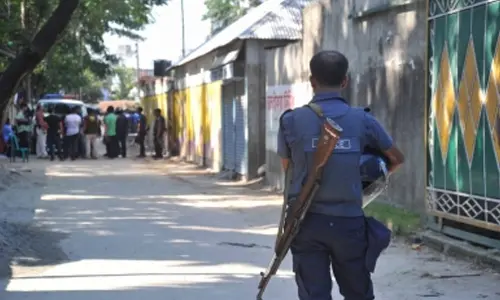No country for Women?

On June 17, a 25-year-old man allegedly raped and murdered a nine-month-old girl in Hanamkonda region of Warangal district in Telangana.
On June 17, a 25-year-old man allegedly raped and murdered a nine-month-old girl in Hanamkonda region of Warangal district in Telangana.
The accused kidnapped the toddler and took her to an ideal place when she was sleeping with her parents on the terrace on their residence.
The moment the victim's parents witnessed that their daughter was missing, they started searching for her and found the accused sexually assaulted the baby — resulting in the baby's death. What a heinous act it is!
Yes, constructed on its poll results, it is true that India, followed by battle-weary Afghanistan and Syria, is the world's most dangerous country for women due to the high risk of sexual violence.
In the Thomson Reuters Foundation survey of about 550 experts on women's issues, India ranked third among the list of notorious and dangerous countries for women safety — held the position above Somalia and Saudi Arabia that are ranked fourth and fifth, respectively.
The aforementioned results are based on the even spread sample across Europe, Africa, the Americas, South East Asia, South Asia and the Pacific — involving as many as 548 people in the poll.
It should be borne in mind that the poll was a reprise of a survey in 2011 in which Afghanistan, Democratic Republic of Congo, Pakistan, India, and Somalia were named as the most dangerous countries for women.
If we have a clear look at the recent crimes that are happening against women and children, one should feel mortified of the society that we live in.
Going back in time to examine the most brutal crimes against women, the 2012 Delhi gang-rape case, also known as Nirbhaya case, involved rape and deadly mugging of 23-year-old Jyoti Singh Pandey.
It happened on December 16, 2012, at Munirka in Delhi, the nation's capital. The victim was gang-raped and contrived in front of her friend, Awindra Pratap Pandey. The girl died eleven days after the incident.
Advancing further in timeline, let it be the April 2018 Kathua gang rape and murder of an eight-year-old girl, or the April 2018 rape case of a 17-year-old girl in Unnao wherein the main accused is a local MLA, or any other brutal crime that is happening in every nook and corner of India, all of them are clear evidence that India is no more a safe place for women.
Also, if we examine the trend of major crime heads in India over the years 1953-2013, palpably there is a steep hike in the crime rate in India (see figure).
If the rapes alone are considered from the time the collection of information was started in 1971, there has been a huge growth of 1255.3 per cent in crimes, according to the National Crime Records Bureau (NCRB) report. This factor itself speaks the aggravated situation of crimes against women in India.
Miserably, in India, there are innumerable cases that remain inaccessible, invisible, and unheard.
Thus, they are not taken into account by any statistical agency for the purpose of computation — otherwise, India may manage to reach the top position, insofar as crimes against women and children is concerned.
Evidently, to control the situation that happened after the Nirbhaya incident, and bowing to the density from various people's unions, the country's Lok Sabha passed the Criminal Law (Amendment) Act, 2013 (Nirbhaya Act) on March 19, 2013.
The same was also passed by the Rajya Sabha on March 21, 2013. This is the major amendment of Indian Penal Code, Indian Evidence Act, and Code of Criminal Procedure, 1973 on laws related to sexual offences.
Then again, in the wake of various child rape incidents, there has been heavy demand for making anti-rape laws more stringent.
More specifically, the demand has been triggered by the shameful Kathua rape case and the Unnao rape case. This resulted in the Criminal Law (Amendment) Act, 2018.
Indubitably, this law has brought significant changes in the criminal law of the country. The very objectives of the law forsee the decrease in the rate of crime.
Besides, it also envisages a decrease in the time taken for investigation and appeal. Another objective of this law is — if implemented properly, unquestionably, it can bring down the crime rate.
However, is there any real progress in the situation? Amendment after amendment is being made as to the nature of crime in itself is changing. But, why there is no progress in bringing down the crime rate has been a million dollar question.
India has a very rich heritage and culture. Nonetheless, adopting foreign culture while neglecting our own is surely one of the reasons behind increased crime rates.
With conviction, it can be justly said that crimes against women are one of the worst problems that India has been facing. There is a dire need to overcome this situation.
Definitely, schools, colleges and universities turn out to be the places that could elicit a change. Of course, the role of the media can not be underestimated in this regard.
'Manu Dharma Shastra' or 'The Laws of Manu' comprising 2684 verses divided into 12 chapters presents the norms of domestic, social, and religious life in India.
Where the discussion is about how men should respect women, the women are described as bearers of many blessings and as not less than Shri (Fortuna, the Goddess of fortune) within the home.
In order to give prominence to rich Indian heritage and culture, instead of looking great works like Manu Dharma Shastra as religious books, they may be included in the school syllabus as part of the course curriculum. Assuredly, to my belief, it would bring about a change!
(The author is an Air Veteran, a mass communicator and an author of more than 10 mass media books)















